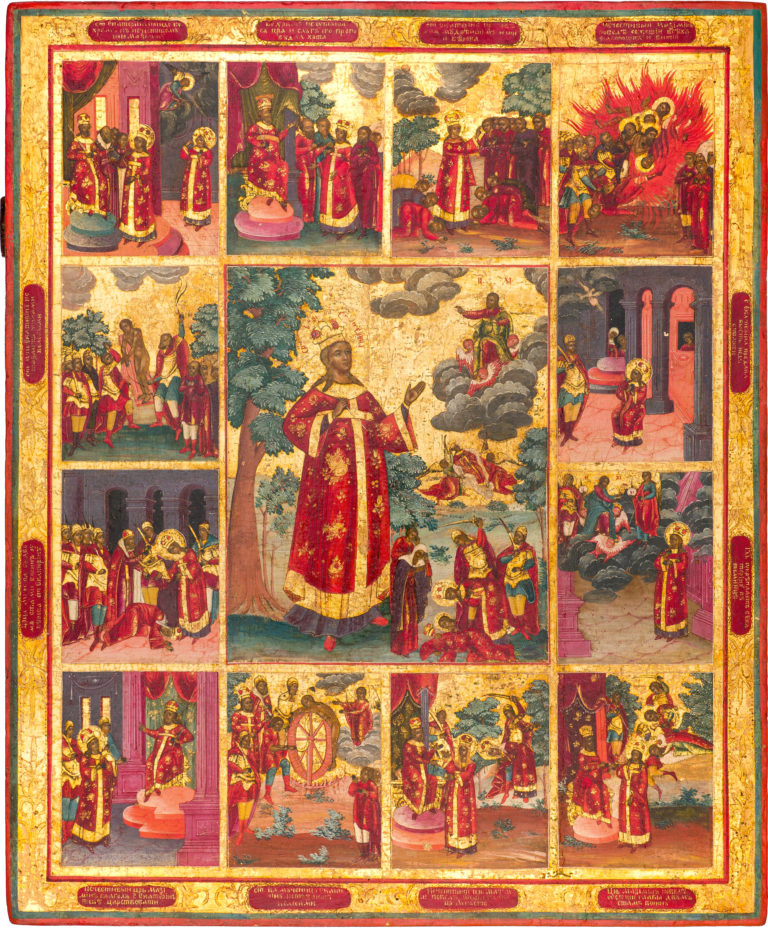The Great Martyr Catherine, with 12 Hagiographical Border Scenes
Antique Russian icon. First half of the 19th century. Vetka.
Size: 53 х 43.5 х 3.5 cm
Wood (two panels), two incut smooth support boards, absence of the incut centerpiece, underlying layer of canvas not visible, tempera, colored lacquers, gold, engraving over gold, embossing over the gesso.
The author’s paintwork is in a good state with only slight chafing and losses of the paint layer. Restoration toning is visible on the background and borders of the antique icon.
Contact us

The Great Martyr Catherine, with 12 Hagiographical Border Scenes
Diagram of the border scenes:
- Saint Catherine comes to the pagan emperor Maxentius;
- Saint Catherine preaches the Christian Faith before the emperor and his servants;
- Saint Catherine preaches before the philosophers and converts them;
- The burning of the converted philosophers;
- The Flagellation of Saint Catherine;
- The Imprisonment of Saint Catherine;
- Saint Catherine is visited in prison by the Empress Augusta and the commander Porphyrius;
- The Revelation of Christ and God’s angels to Saint Catherine in her prison;
- Saint Catherine is brought before the Emperor Maxentius;
- Saint Catherine is freed from the wheel of torture;
- The beheading of the Empress Augusta;
- Emperor Maxentius orders the beheading of commander Porphyrius and his warriors.
The given antique Russian icon is a perfect example of hand-painted Orthodox icons of saints. The Great-martyr Catherine of Alexandria († 305?) is one of the most venerated saints of the Christian world. There is no historical evidence concerning her life – all versions of her Vita are variations of the Greek manuscript written down in the early 6th century. According to them, Catherine was born in Egyptian Alexandria and was the daughter of a certain Emperor Constantine. The young Catherine was a girl of rare beauty and extreme skills. She brilliantly studied natural and humanitarian science, read the works of all known antique poets and historians, and spoke 72 languages. Catherine came to the Emperor Maxentius (or Maximine) preaching Christianity. Struck by her beauty and wit, the Emperor could not argue with her and called the pagan philosophers. Catherine won the hard dispute and converted the philosophers to the Christian faith. On hearing this, the Emperor fell into a rage and ordered the philosophers to be burnt at the stake, while Catherine was to be imprisoned and tortured. In prison, Catherine was visited by the Empress Augusta and the commander Porphyrius accompanied by a troop of 200 warriors. After a conversation with Catherine, all those who visited her were converted. In order to strengthen the martyr, Christ himself came to her prison, accompanied by a host of angels. Since the saint did not renounce her faith, Maxentius ordered for her to be put on a wheel of torture, but when Catherine was tied to the wheel, the mechanism miraculously broke. The anger of the emperor was such that when the Empress Augusta tried to intercede on Catherine’s behalf, Maxentius ordered for her to be tortured and executed. At the same time, he ordered the execution of Porphyrius and his Christian warriors. Catherine was beheaded on the next day. At the time of her execution, a miracle appeared: instead of blood, milk issued from her wounds. At that very moment, four angels came down from the heavens and took Catherine’s body away – to a mountain which stood near Mount Sinai. It was here that around the year 800, relics of Saint Catherine were found, and the mountain since that time was called St. Catherine’s Mount. The relics are kept in the Sinai Transfiguration Monastery known as St. Catherine’s Monastery since the 9th century. The Feast of St. Catherine is celebrated on December 7th (November 24th according to the Julian calendar).
In Russia, the first hagiographical religious icon paintings of Saint Catherine appeared in the 16th century and became widespread in the Imperial period. The given hand-painted icon was obviously a personal commission. It is a detailed variation of Catherine’s hagiography, typical for later-period Eastern Orthodox icons of saints. The scenes of Catherine’s execution and the Translation of her relics are brought into the centerpiece.
The stylistic traits indicate that the given antique icon was painted in Vetka – one of the largest Russian icon painting centers of the Old Believers, located in the western provinces of the Empire. Vetka’s hand-painted Orthodox icons are instantly recognizable because of their incredible artistry, decorative traits, a bright, powerful color pallet, especially the “burning” crimson-red tones, the rhythmical color accents, the rich ornamentation of the vestments and on the borders (the baroque flower motif), and the vast expanses of gold. This antique Russian icon of Saint Catherine is a wonderful piece of work, beautifully executed in both composition and technique, with special attention given to perspective. It is one of the grandest examples of Vetka’s Eastern Orthodox Church icons of saints of the first half of the 19th century.